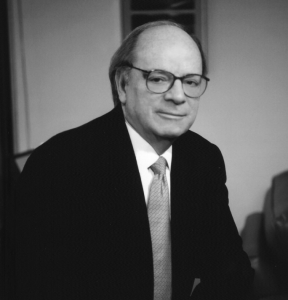This post is part of The Plank Center’s Legacies from Legends in PR Series that was begun in recognition of the 40th Anniversary of the Public Relations Student Society of America in 2007.
Serves as chief marketing and communications officer at Accenture. Previously served as chairman and CEO of Burson-Marsteller Americas and as the senior communications and public affairs officer for Merrill Lynch, Beatrice and Owens-corning. Recognized as Business Marketer of the Year by BtoB Magazine. Named Public Relations Professional of the Year by the Public Relations Society of America. Elected to the Hall of Fame of the Arthur W. Page Society (2005). Past president of the Page Society and current chair of the PR Coalition.
When I graduated from college, I was ready to tackle the world but with not a clear idea of what was in store for me. It was probably just as well since it turned out to be quite a ride. During my career in public relations, I have worked for four global companies, 13 CEOs and a major agency, plus my own family agency. I have traveled to most of the major countries in the world and worked on just about every kind of business situation you can imagine.
My advice for anyone contemplating a public relations career is to approach it with eyes and mind wide open, be accepting of change, never fear challenges and, along the way, try to enjoy every minute of what can be a highly satisfying career choice.
To achieve success in this highly competitive field–and in the world of corporate communications that means gaining a seat at the policy-making table of senior management–you have to develop skills that go well beyond the basic public relations capabilities that you will use as you climb the management ladder.
Your focus has to be on the business you are serving. That requires a deep understanding of the company, its cultures and it values. You also need to know the dynamics of the business, its strategies and goals and, above all, the expectation of the company’s leadership.
In addition, you have to be an ambassador to the larger world. Perhaps more than any other executive besides the CEO, the chief public relations officer must know what is going on inside and outside the organization and how the company’s plans and actions relate to it various publics. That is an increasingly tough job because in the 24/7 news world we live in today, and the multiple information sources that are available to everyone, there are no secrets and no way to avoid public criticism if your actions don’t meet with public approval.
It is the chief public relations officer’s job to see that the perspective he or she has developed about the business and its publics is heard, understood and heeded by management. In other words, bring awareness and objectivity about what is happening in the world-at-large to the table and in doing so inject credible, usable information into the decision-making process. As you might expect, it’s not always a comfortable role to play, but if you have earned the respect of your peers and developed credibility in everything you do, you will more often than not be listened to.
One of the most challenging aspects of today’s public relations job has been the development of the global marketplace. It has changed both the way that corporations do business and the way we must practice public relations. We now must interact with globally connected media and with different cultures that view the world from different perspectives. More than ever before, corporate PR professionals must be good social scientists as well as good social counselors. It’s a challenge we should all welcome. It’s what makes us better public relations professionals.
